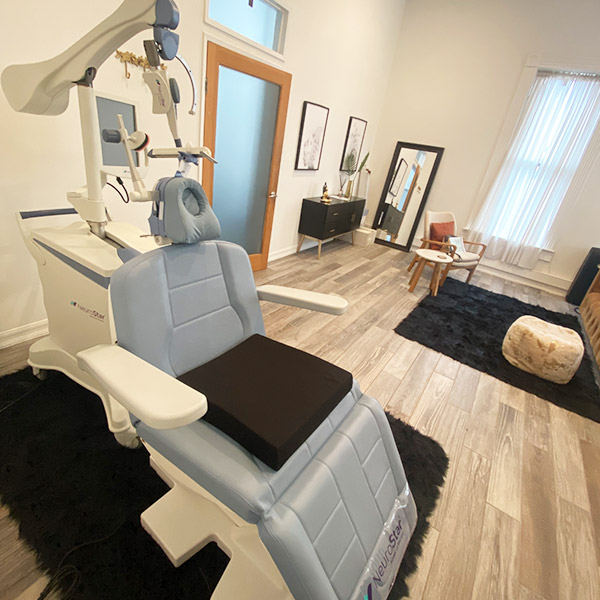TMS Therapy, A Treatment For Post-Traumatic Stress
A horrible accident might just come knocking on your door at any given moment, leaving long-lasting physical and psychological impacts. Most folks experience trauma in their lifetime, and 1 out of 3 will fail to fully recover and constantly experience frustrating side effects such as depression, anxiety, endless nightmares, and disturbing flashbacks.

In extreme cases, some even lose interest in their favorite activities for extensive periods. These permanent symptoms are telltale signs of Post-Traumatic Stress Disorder (PTSD). But fear not! There are various treatments for PTSD based on symptoms as well as their severity. TMS (Transcranial Magnetic Stimulation) therapy is among the most successful PTSD treatment approaches.
This treatment affects the central nervous system activity by applying magnetic fields. TMS is typically used after all other methods and treatments fail to work for a patient. It has been approved by the US Food and Drug Administration (FDA) and has proven to be highly effective. Here below, we'll take a closer glance at TMS therapy and PTSD.
PTSD Diagnosis Criteria
Trauma is a major component of a PTSD diagnosis, commonly defined as an encounter with actual or possible death, serious injury, sexual violation, or other forms of violence, such as:
- Suffering traumatic events firsthand
- Seeing traumatic events firsthand
- Finding out that traumatic events happened to a close relative or acquaintance
Repeated or ongoing exposure to unpleasant details of traumatic incidents, e.g., first responders collecting human corpses, police officers frequently exposed to evidence of child abuse, can be just as devastating as physical trauma.
Yes, it's true that when one thinks of trauma, near-death situations, war, sexual assault, and physical abuse are likely scenarios that come to mind. However, it’s key to remember mental abuse is equally as traumatic as physical abuse.
TMS When All Else Fails
Some trauma victims develop post-traumatic stress disorder (PTSD) after a traumatic incident. PTSD is a severe psychiatric disease distinguished by the intrusion, avoidance, negative mood, cognitive abnormalities, and hyperarousal.
Other trauma-related illnesses, such as neuropsychiatric disorders, including traumatic brain injury (TBI), major depression, and alcohol use disorders (AUDs), are becoming more common in people with PTSD.
Moreover, the frequency of PTSD in those who have had a TBI has been rising in tandem with the increase in crime and accident rates. Anyone with PTSD or TBI knows how great of an effect these mental issues have on the quality of life, making it imperative that these problems be addressed and treated under the supervision of professionals.
One-third of PTSD patients prescribed traditional medications like antipsychotic drugs and antidepressants are still diagnosed with PTSD. This ratio is also true for those who've had therapy sessions like behavioral treatment, eye movement desensitization, and reconstruction. What makes it even more complicated is that TBI and similar medical symptoms often have a low response/compliance to normal medicinal and even non-medicinal treatments, like workout and rehabilitation.
TMS therapy works by deploying electromagnetic impulses delivered by an electromagnetic coil to stimulate the cells in specific brain regions, like vmPFC. This treatment also acts as a cell control mechanism of sorts in other brain regions linked to PTSD, potentially restoring normal activity levels of neurons.
TMS studies have demonstrated its therapeutic effects on PTSD symptoms, as well as improvement of neurological, cognitive, and mental symptoms (sans any major side effects).
What Is It & How It Works
Transcranial magnetic stimulation is a non-invasive brain stimulation treatment. A coil attached to the patient's scalp sends rapid pulses modifying the brain's electromagnetic fields. TMS is now widely and efficiently practiced in various clinical settings, including psychology and neuroscience. Modifiable TMS parameters such as target brain area or frequency vary contingent on the patient and different clinical purposes.
TMS doesn't require anesthesia; it’s often “well-tolerated”, and has zero to negligible side effects. Headache is the most common side effect during or immediately after therapy. TMS may not be suitable for folks with a high risk for seizure (epileptics), individuals who’ve had head injuries, and those with serious neurologic disorders. Seizure is an exceptionally rare but dangerous side effect of TMS, and those with episodes of seizures in their prior medical history are more prone to them.
TMS Procedure & What Happens During Each Session
TMS utilizes magnetic pulses; hence patients must remove any magnetic-sensitive items before starting therapy, such as jewelry, credit cards, etc. TMS creates a loud clicking noise with each pulse, similar to an MRI machine; consequently, individuals are asked to wear earplugs for comfort and noise-canceling throughout the treatment. The entire TMS session transpires while the patient is sitting down.
Physicians/technicians take multiple measurements during the initial TMS session to make sure that the TMS coil is correctly positioned over the patient's skull. After that, the TMS coil is placed above the patient's head. Next, the TMS physician uses a series of short pulses to determine the patient's motor threshold.
The motor threshold is the minimal level of power required to cause the patient's thumb to twitch (varies depending on the person). Doctors apply the motor threshold to adjust treatment settings and calculate how much energy is needed to stimulate neurons.
Once the motor threshold has been determined, the coil is placed over the front area of the patient's brain. Patients will hear a sequence of clicking noises and notice a tapping feeling under the treatment coil during the procedure. Henceforth, the treatment process begins.
TMS, a Great Treatment for PTSD
People with PTSD have a variety of impaired brain regions/functions. The following are essential brain components susceptible to change as a result of trauma:
- The limbic system: This system includes the amygdala. This almond-shaped tissue deals with survival instincts and the way humans communicate emotions, particularly fear.
- The ventromedial prefrontal cortex (vmPFC): Is a more advanced brain region that handles emotions.
- The hippocampus: Memories are stored and retrieved by the hippocampus.
According to brain scans, PTSD patients have lower brain activity in the vmPFC and a hyperactive amygdala. These scans also reveal that vmPFC gradually loses control of the amygdala, inducing severe anxiety.
The hippocampus, which aids in the separation between past and present, also weakens. In extreme cases, PTSD patients could have a challenging time distinguishing between the trauma in their head and reality.
Many PTSD patients are resistant to treatment. Often, they’ve tried all of the traditional treatments, but none of them have helped. Medications, such as SSRI antidepressants, are generally included. Trauma-focused cognitive therapy (TF-CBT), eye movement desensitization, and reprocessing are examples of talk therapy (EMDR), which sometimes also fail to work.
TMS therapy has been shown to be an effective PTSD treatment in numerous studies. Since TMS therapy and PTSD seem to be working so well together, it can be positively stated that TMS is a promising alternative to conventional therapies that have failed. TMS therapy may not eliminate your PTSD symptoms, but it can assist patients in lessening its effects and making them more manageable.
Look for Signs of Improvement
TMS treatments for PTSD typically consist of five sessions per week for up to six weeks, followed by a three-week phase of less frequent sessions. Patients have indicated their PTSD symptoms tend to become less severe after a regular series of sessions, with a significantly lower chance of recurring.
Although each individual's PTSD symptoms are unique, common PTSD symptoms that may experience improvement after a while include:
- Vivid flashbacks (as if the painful incident is being relieved)
- Haunting thoughts & images
- Nightmares
- Intense distress when confronted with actual or metaphorical reminders of the tragic event
- Physical symptoms such as discomfort, perspiration, nausea & trembling
- Hypervigilance (state of extreme awareness)
- Sleep Issues
- Violent behavior & instability
- Self-destructive behaviors (like narcotic & alcohol abuse)
- Emotional numbness
Patients improve at varying times depending on a number of factors, including the severity of their PTSD symptoms and the length of time they've been suffering from it. Many notice positive results in as little as a few weeks, while it may take longer for others.
TMS: A Novel Treatment
TMS produces a clinically relevant response in up to sixty percent of those who have tried and failed in other treatments. It’s imperative to recognize that while these outcomes are positive, they’re not permanent. There’s always a rate of recurrence, as with most other treatments.
Nevertheless, most TMS patients continue to feel better for months after completion of therapy, with the average response time being just over a year. Some opt to return for more treatment, while others refrain.
Even though physicians and psychiatrists customarily prescribe TMS for primary depression treatment, the fact is that TMS has proven itself to be a highly effective treatment for PTSD, anxiety disorders, and even nervous system disorders like Parkinson's. In addition to psychiatry, researchers are studying TMS extensively across illnesses and disciplines in the hopes of developing new treatments for neurological conditions, pain control, and rehabilitation programs.
TMS Therapy Insurance for PTSD
The FDA approved TMS in 2008 for the treatment of depression. TMS has yet to be approved for other conditions such as PTSD, generalized anxiety disorder (GAD), and obsessive-compulsive disorder (OCD). As a result, some insurance companies do not cover the cost of TMS therapy for PTSD.
PTSD patients often suffer from depression as well. In these circumstances, we’ll work with you to treat both (with your insurance paying for all the depression treatments). To verify where you stand with your insurance company, contact them in advance to make the process easier.
Final Word
When PTSD symptoms are severe and overwhelming, they can become an issue at work, in relationships, and in everyday life. Consequently, individuals who have PTSD must seek treatment immediately.
TMS therapy can help manage symptoms by reducing the severity and providing more self-control. It has indeed worked miracles on treatment-resistant patients. The foreseeable future is bright when it comes to the tandem of TMS & PTSD. Moreover, TMS can help sufferers regain control of their life without the adverse side effects of conventional medication.
At Los Angeles Therapy Institue, we pride ourselves on our customer satisfaction and long-lasting results. Please don't hesitate to contact us if you are interested in TMS therapy. Our experts will be more than happy to help you out.


